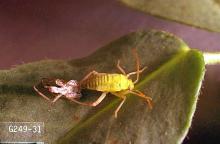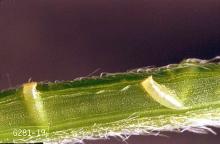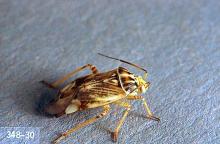Lygus spp.
Pest description and crop damage Adults are about 0.2 inch long, with a light yellow V on their back at the base of the wings. They vary from light brown to green. Lygus bugs use piercing-sucking mouthparts to feed on the umbels, which causes aborted buds, blossom drop, and shriveled seeds. Adults and late stage nymphs are the most injurious stages, but the smaller nymphs are easiest to control.
Scouting and thresholds Lygus bugs move into carrot fields in the late spring and early summer. During the pre-bloom period growers should scout for lygus bugs in the morning or evening. One lygus bug per umbel can result in economic damage in carrot seed crops.
Management-chemical control
- acephate (Orthene 97) at 1 lb/A (1.03 lb ai/A). REI 24 hr. For suppression of lygus bugs. Use of a buffering agent and anti-drift agent is suggested. Allow a minimum of 7 days between applications. Do not apply more than 2 lb/A (1.06 lb ai/A) per crop year. Do not apply through any type of irrigation system. This product is highly toxic to bees exposed to direct treatment on blooming crops or weeds. Do not apply to blooming carrot seed crops during the pollination period. Do not spray if there is another seed field within a half mile that is being pollinated. No portion of treated plants can be used for food or feed. 24c SLNs: Orthene 97 (Oregon and Washington only) OR-090025 (expires 12/31/25), WA-090021 (expires 12/31/28).
- azadirachtin (Aza-Direct, Neemix 4.5)-See label for rates. PHI 0 days. This is a botanical insecticide with ingestion and contact action that kills immature stages by interfering with molting; also reduces damage by repelling and deterring feeding. Apply at 7- to 10-day intervals, when pests first appear and are in the early nymph stage. Repeat applications break the life cycle of the pest. Some formulations are OMRI-listed for organic use.
- bifenthrin (Bifenture EC) at 3.9 to 6.4 fl oz/A (0.06 to 0.1 lb ai/A). REI 12 hr. Do not make applications more than 21 days apart. This product is highly toxic to bees exposed to direct treatment or residues on blooming crops or weeds. Use prebloom (allow 5 days before introducing pollinators) or after pollination. Do not exceed two or three applications per crop year (restrictions vary with each 24c SLN label). There are some restrictions pertaining to rotation crops. Extremely toxic to fish and aquatic invertebrates, so follow buffer zone restrictions on the label. Do not apply through chemigation. No portion of treated plants can be used for food or feed. 24c SLNs: WA-070014 (expires 12/31/27) Washington only. See the Carrot section for more allowed bifenthrin products.
- gamma-cyhalothrin (Declare) at 0.01 to 0.015 lb ai/A. REI 24 hr. Do not exceed 0.06 lb ai/A per season. This product is highly toxic to bees exposed to direct treatment or residues on blooming crops or weeds. The low rate may be applied from late evening to midnight during bloom. Do not apply at the 0.015 rate to blooming seed crops. Toxic to fish and aquatic invertebrates. Do not apply within 25 ft of an aquatic habitat, 150 ft if applied by air. Apply with ground or air equipment. Section 18 label allows application to carrot seed in Idaho and Oregon only.
- lambda-cyhalothrin (Paradigm VC, Silencer VXN, Warrior II with Zeon Technology) at 0.02 to 0.03 lb ai/A. REI 24 hr. Do not exceed 0.12 lb ai/A per season. This product is highly toxic to bees exposed to direct treatment or residues on blooming crops or weeds. The low rate may be applied from late evening to midnight during bloom. Do not apply at the 0.03 rate to blooming seed crops. Toxic to fish and aquatic invertebrates. Do not apply within 25 ft of an aquatic habitat, 150 ft if applied by air. Do not apply through any type of irrigation system. No portion of treated plants can be used for food or feed. Section 18 labels for Paradigm VC and Silencer VXN allow applications to carrot seed crops. 24c SLNs: Warrior II (Washington only) WA-100002 (expires 12/31/25).
- naled (Dibrom 8E) at 1 to 1.5 pints/A (0.9 to 1.4 lb ai/A). REI 48 hr. Do not apply more than 3 pints/A (2.8 lb ai/A) per year. This product is highly toxic to bees exposed to direct treatment on blooming crops or weeds. Allow 48 hr after application before introducing bees for pollination. Do not apply if another seed crop within half a mile is being pollinated by honeybees. This product is toxic to fish, aquatic invertebrates, and wildlife. Do not apply directly to water. Do not apply by ground within 25 feet of bodies of water. Do not apply by air within 150 feet of bodies of water. Do not apply through any type of irrigation system. No portion of treated plants can be used for food or feed. 24c SLNs: (Oregon and Washington only) OR-990032 (expires 12/31/25), WA-990028 (expires 12/31/28).




